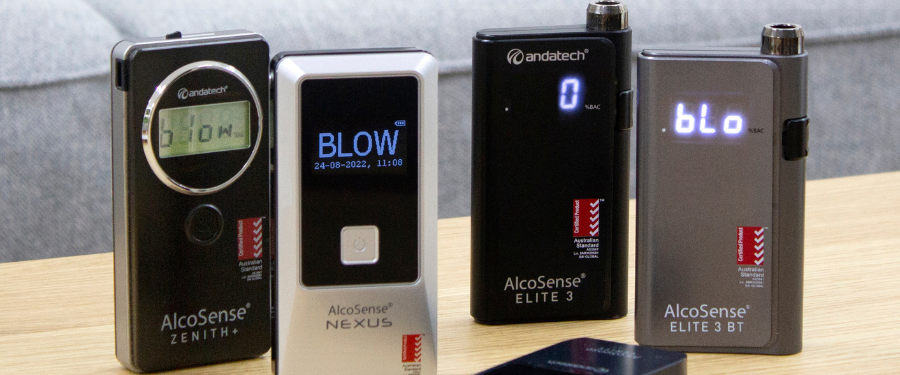All your questions about breathalysers and how they work are answered in this in-depth breakdown of frequently asked questions about breathalysers.
How does a breathalyser work?
Breathalysers work by analysing a breath sample blown into the device and calculating the concentration of alcohol that is found within the breath sample or breath alcohol concentration (BrAC).
The breath sample will be exposed to a platinum fuel cell within the breathalyser, which promotes the oxidation of any alcohol molecules found in the sample. This will cause an electric current generation, which is measured by the unit and used to calculate the person's BrAC, which is then converted into blood alcohol content (BAC) for easier reading.
Semiconductor breathalysers, however, have a different process.
Learn more: Semiconductor vs. Fuel Cell breathalysers
Are breathalysers accurate?
Breathalysers are the easiest and most accurate way to estimate a person’s intoxication level by measuring the concentration of alcohol found in an individual’s breath sample.
Other ways to measure or calculate a person’s BAC level can be done through a blood test or a saliva/urine test. All of which are most costly and time-consuming. On top of that, not all of these results will be able to give an accurate reading and may just detect the presence of alcohol. Another method to measure BAC is through guesstimation via online calculators, which is one of the least accurate ways to measure one’s BAC level.
What is the BAC limit for driving in Australia?
The BAC limit for driving in Australia is 0.05%BAC. Recording this BAC or higher can result in hefty penalties and endanger the driver and those on the road.
It’s worth noting that it is never safe to drink any alcohol before driving, as one’s senses could be impaired.
Learn more: Drink driving penalties in Australia
How many drinks does it take to reach 0.05%BAC?
It is difficult to estimate how many drinks it takes to reach the legal BAC limit because of factors such as the strength of alcoholic drinks (amount of alcohol in the drink), nutrition before drinking, and individual factors such as weight, gender, body fat percentage, age, etc.
A general rule of thumb is that two standard drinks (one standard drink is equal to 10g or 12.5ml of pure alcohol) in an hour can raise your BAC to 0.05 for men, but less than one standard drink can have the same effect for women. However, this rule may not apply to everyone because of the factors mentioned above.
For more information on this question, read our blog post ‘How many standard drinks to 0.05’.
What should I do if I blow over the limit of 0.05?
If you blow a BAC reading of 0.05% or higher, avoid drinking any more alcohol and do not drive. If you have to travel to get home, it’s best to arrange for a safe ride by calling a cab, a rideshare service or a sober friend to help you find your way.
Driving when impaired could potentially lead to a lot of harm and trouble with law enforcement authorities.
Learn from this experience and arrange for alternative transportation the next time you plan a night out drinking.
How long should I wait to drive after drinking alcohol?
The time you wait to drive before having alcohol depends on several factors, such as strength of drink, age, gender, metabolism rate, and more. Generally, the safest approach to this is to not drive on the same night you were out drinking because alcohol can stay in your system for as long as 12 hours, considering the factors above.
LEARN MORE: How long does alcohol stay in your body?
Can breathalysers also detect drugs?
Breathalysers generally cannot detect the presence of drugs or other substances as that would require a saliva, urine, blood or hair sample.
These samples will be tested for the presence of drug metabolites in a lab or via a drug test kit. Drug test kits from Andatech, like the DSO8 Plus are able to detect the presence of alcohol within a saliva sample. However, it is not able to measure a BAC reading within the said sample.
Does mouthwash affect breathalyser results?
Mouthwash can affect a breathalyser's test results and cause a false positive, as many mouthwash products contain alcohol that may linger in one’s mouth after use. This alcohol may accidentally be blown into the breathalyser and record a higher reading than usual.
Because of this, Andatech recommends to wait 15-20 minutes after eating or drinking before using your breathalyser.
LEARN MORE: Breathalyser myths
How often should I calibrate my breathalyser?
Your breathalyser should be calibrated every 12 months to ensure accurate readings at all times. This applies to both personal units and workplace units, as this level of frequency is also recommended by Australian Standards guidelines. However, other breathalysers may need to be calibrated at different frequencies depending on the manufacturer's guidelines.
Both Andatech workplace and personal breathalysers have been Australian Standards certified and are eligible for extended guarantee up to a lifetime if calibrated regularly. Learn more about breathalyser calibration in our blog post, ‘What is breathalyser calibration?’
Browse through Andatech’s range of high-quality breathalysers and drug testing equipment to find the right unit or test kit to suit your alcohol and drug testing needs.





